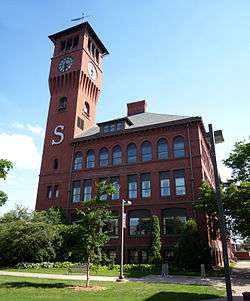University of Wisconsin–Stout
The University of Wisconsin–Stout (UW–Stout or Stout) is a public university in Menomonie, Wisconsin. A member of the University of Wisconsin System, it enrolls more than 9,600 students. The school was founded in 1891 and named in honor of its founder, lumber magnate James Huff Stout.
 | |
| Type | State university |
|---|---|
| Established | 1891 |
| Endowment | $64,505,176 (2019)[1] |
| Chancellor | Katherine Frank |
Administrative staff | 483 |
| Students | 9,401 (Fall 2017) |
| Undergraduates | 8,116 (Fall 2017) |
| Postgraduates | 1,285 (Fall 2017) |
| Location | , , United States |
| Campus | Rural (Large Town) 124 acres (50 ha) |
| Colors | Blue and White[2] |
| Athletics | NCAA Division III Wisconsin Intercollegiate Athletic Conference National Collegiate Gymnastics Association |
| Nickname | Blue Devils |
| Website | www |
 | |
Stout is "Wisconsin's Polytechnic University".[3] It is one of two special mission universities in the University of Wisconsin System and provides focused programs "related to professional careers in industry, technology, home economics, applied art, and the helping professions."[4] UW–Stout offers 50 undergraduate majors and 26 graduate majors, including 2 advanced graduate majors and a doctorate.[5][6]
History

In 1891, James Huff Stout, a Wisconsin State Senator and Menomonie resident, founded a manual training school, the first of several educational enterprises he launched in Menomonie. The Manual Training movement was an educational philosophy that influenced modern vocational education. In the United States, this philosophy was established in the 1870s and used to train engineers, later working its way into public education. Manual training promoted a classical liberal education, but emphasizing practical application such as practical judgment, perception and visual accuracy, and manual dexterity over theory. It was not meant to be used to teach specific trades, but rather to enhance the traditional educational model. Students learned drafting, mechanics, woodworking, metal working, in addition to science, mathematics, language, literature, and history. After the American Civil War, leaders of industry and politics were turning to public education to augment existing apprenticeship programs by incorporating Manual Training philosophy into their curricula.[7]
Stout was influenced by the Arts and Crafts Movement, the philosophies of which influenced his own philosophy of education, specifically that making things by hand, through skill and creativity, would provide more thoughtful and creative consumer goods because of the personal satisfaction of the craftsperson. The American interpretation of the Arts and Crafts movement was not in opposition to modern industry. Rather, it embraced creativity and intellectual development as necessary components of the educational model, leading the school to teach classes in drawing, jewelry making, embroidery, and photography.[8][9]
In addition to the Stout Manual Training School, James Huff Stout established kindergarten classes (1894), a Kindergarten Training School (1899), a School of Physical Culture (1901), training schools for manual training teachers and domestic science teachers (1903), and a Homemaker's School (1907).[4] In 1908, to simplify and clarify administration, Stout merged the various institutions owned by him into the Stout Institute, which was sold to the state of Wisconsin after Stout's death in 1911.[4] The school was governed by its own board of regents until 1955, when it became part of the Wisconsin State Colleges system as Stout State College. The state colleges were all upgraded to university status in 1965, and accordingly Stout State College became Stout State University. In 1971, after the merger of the former University of Wisconsin and the Wisconsin State Universities, the school became part of the University of Wisconsin System and has been named University of Wisconsin–Stout since then.[4] In March 2007, UW-Stout was designated "Wisconsin's Polytechnic University" by the UW System Board of Regents.
Academics
UW–Stout offers 50 undergraduate majors, 26 graduate majors, and 53 minors.[10][10] The Graduate School provides oversight for graduate education at the university. UW–Stout offers three terminal degree programs; the Master of Fine Arts in Design, the Educational Specialist degree in both School Psychology and Career and Technical Education, and the Doctor of Education in Career and Technical Education.[11]
Colleges and schools
UW-Stout is organized into three colleges: the College of Arts, Communication, Humanities and Social Sciences, which houses the School of Art and Design; the College of Education, Hospitality, Health and Human Sciences, which houses the School of Education and the School of Hospitality Leadership; and the College of Science, Technology, Engineering, Mathematics and Management, which houses the Robert F. Cervenka School of Engineering.
The Graduate School provides oversight for graduate education at the university.[12]
English as a Second Language Institute
The English as a Second Language Institute offers year-round English immersion courses to non-native English speakers.
Campus

UW–Stout is made up of two parts: a main campus and north campus, which is mostly residence halls and dining and health facilities. The campus is 124 acres (50 ha) with 25 major academic and administrative buildings, 10 residence halls, and 245 laboratories.
Buildings and facilities
- Student Health Center
- Louis Smith Tainter House
 The Louis Smith Tainter House houses the Stout University Foundation and the Stout Alumni Association. Built as a private home, it is listed on the National Register of Historic Places.
The Louis Smith Tainter House houses the Stout University Foundation and the Stout Alumni Association. Built as a private home, it is listed on the National Register of Historic Places. - Harvey Hall
- Bowman Hall
- Sorensen Hall
- Heritage Hall (formerly Home Economics Building)
- Fryklund Hall
- Communication Technologies Building
- Millennium Hall
- Vocational Rehabilitation Building
- Robert S. Swanson Library and Learning Center
- Memorial Student Center
- Administration Building
- General Services Building
- Merle M. Price Commons
- Jarvis Hall (Technology Wing, Science Wing and Science Wing Addition)
- Micheels Hall
- Applied Arts Building
- Johnson Fieldhouse
- Sports and Fitness Center
- Adventure Challenge Course
- Alumni Field
- Heating Plant
- Don and Nona Williams Stadium
- Burton E. Nelson Field
- North Point Dining and Fitness Center
- Child and Family Study Center
- North Hall
- South Hall
- HKMC (Hansen-Keith-Milnes-Chinnock Halls)
- CKTO (Curran-Kranzusch-Tustison-Oetting Halls)
- AFM (Antrim-Froggatt-McCalmont Halls)
- Fleming-Hovlid Hall
- Red Cedar Hall
- Wigen Hall
- JTC (Jeter-Tainter-Callahan Halls)
Residence halls
More than 3,000 students live on campus. All freshmen and sophomores are required to live on campus for their first two academic years. Housing includes traditional dorms and modern suite-styled rooms. There are ten residence halls. All are co-ed.
Research
The university was designated Wisconsin’s Polytechnic University by the UW System Board of Regents in the spring of 2007.[13] In 2013, officials from MIT helped open a fab lab on the UW-Stout campus, the only university in Wisconsin with such a facility.[14]
Research centers and programs
- Applied Research Center
- Archives and Area Research Center
- Assistive Technology and Assessment Center
- Center for Applied Ethics
- Center for Nutrition Education
- Child and Family Study Center
- Discovery Center (home to the UW-Stout Fab Lab)
- Nakatani Center for Learning Technologies
- UW-Stout Manufacturing Outreach Center
- People Process Culture
- Risk Control Center
- Stout Vocational Rehabilitation Institute
Stout Technology and Business Park
Just east of the main campus lies the Stout Technology and Research Park, an area housing facilities and laboratories dedicated to research, high technology, engineering, product development and prototype manufacturing, product testing, experimental and commercial testing, and light manufacturing. Business and industry entities located in the STBP include facilities owned by 3M, Andersen Corporation, and ConAgra Foods.[16]
Athletics
UW–Stout's athletic varsity teams mascot is the Blue Devils and the school colors are navy blue and white. The school competes in the WIAC in NCAA Division III. The women's gymnastics team is affiliated with NCGA (National Collegiate Gymnastics Association).
As a DIII university, student athletes compete without the benefit of athletics aid or scholarships. Men's teams include: football, baseball, basketball, cross country, golf, ice hockey and track and field. Women's teams include: basketball, cross country, golf, gymnastics, soccer, softball, tennis, track and field, and volleyball.
Notable alumni
- Tony Beckham, former NFL player
- Vera C. Bushfield, former U.S. senator from South Dakota
- Alice Clausing, former Wisconsin State Senator
- Rikard Grönborg, ice hockey coach
- Oties Epps, head coach of the University of Evansville women's basketball team
- Harvey M. Haakenson, U.S. National Guard general
- Jeff Hazuga, former NFL player
- Karen Heagle, American Artist
- Hubert C. Hegtvedt, U.S. Air Force general
- Luke Helder, Midwest pipe bomber
- Emil C. Kiel, U.S. Air Force general
- Robert J. Larson, former Wisconsin State Representative
- Scott D. Legwold, U.S. National Guard general
- Bob McRoberts, former NFL player
- Cindy Pawlcyn, James Beard Foundation award recipient for Best American cookbook
- John Peterson, Olympic gold medalist
- Bob Raczek, hall-of-fame high school football coach
- Gary Ronning, bodybuilding champion
- Ewald J. Schmeichel, former Wisconsin State Representative
- Tony Storti, head coach of the Montana State Bobcats football team
- Joe Vavra, quality control coach for the Detroit Tigers
- Gus Johnson, YouTube personality and comedian
- Eliza Wheeler, children's book illustrator
- Nancy Zieman of Sewing with Nancy
- David Zien, former Wisconsin state senator
References
- "Form 990". Retrieved 2019-07-05.
- http://www.uwstout.edu/identity/upload/identityStandardsRev2015_v9.pdf
- "UW-Stout is Wisconsin's Polytechnic University". Uwstout.edu. 2015-08-14. Retrieved 2015-09-19.
- "What's in a Name?". Uwstout.edu. 2015-08-14. Archived from the original on 2012-04-13. Retrieved 2015-09-19.
- "Graduate Degree Programs at UW-Stout". www.uwstout.edu. Retrieved 2015-10-20.
- "Undergraduate Degree Programs at UW-Stout". www.uwstout.edu. Retrieved 2015-10-20.
- "Manual Training Movement". nd.edu. Retrieved 2015-09-19.
- Bryan, James E. "The Stout Institute and Educational Innovation". Wisconsin101.org.
- Bryan, James E. "The Arts & Crafts Movement". Wisconsin101.org.
- "Academic Minors at UW-Stout". www.uwstout.edu. Retrieved 2015-10-20.
- "Graduate Degree Programs at UW-Stout". Uwstout.edu. 2015-08-14. Retrieved 2015-09-19.
- "Academics". University of Wisconsin-Stout.
- "StoutQuest : The Journal of Research at University of Wisconsin-Stout" (PDF). Uwstout.edu. 2010. Archived from the original (PDF) on 2012-10-31. Retrieved 2015-09-19.
- "UW-Stout News Story". Uwstout.edu. Retrieved 2015-09-19.
- "Research Centers and Programs". Uwstout.edu. 2015-08-14. Retrieved 2015-09-19.
- "Stout Technology and Business Park Owners". Uwstout.edu. 2015-08-14. Retrieved 2015-09-19.
- "Blue Devil mascot introduced at Thursday's game". Athletics University of Wisconsin - Stout. University of Wisconsin - Stout. Retrieved 18 November 2015.
External links
| Wikimedia Commons has media related to University_of_Wisconsin-Stout. |